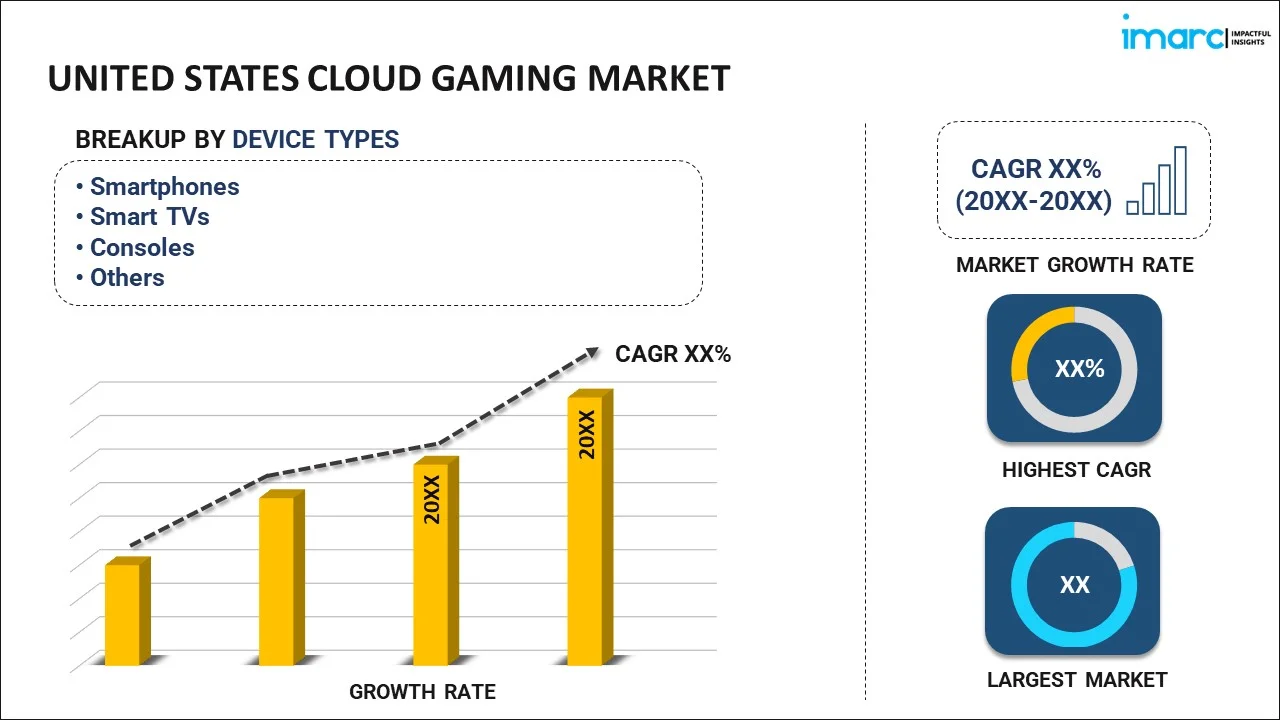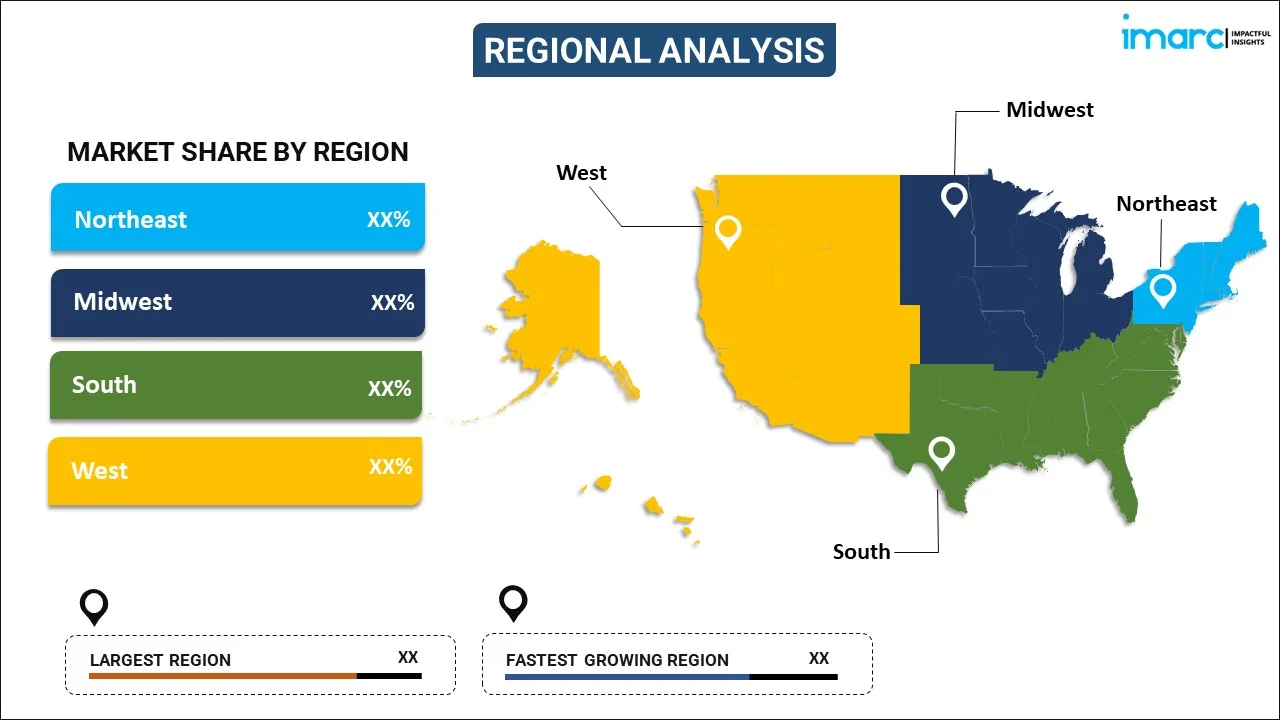
United States Cloud Gaming Market Report by Device Type (Smartphones, Smart TVs, Consoles, Tablets, PCs), Genre (Adventure/Role Playing Games, Puzzles, Social Games, Strategy, Simulation, and Others), Technology (Video Streaming, File Streaming), Gamer (Hardcore Gamers, Casual Gamers), and Region 2025-2033
Market Overview:
United States cloud gaming market size is projected to exhibit a growth rate (CAGR) of 31.05% during 2025-2033. The increasing improvements in streaming technology, including low-latency streaming, which have made it possible for gamers to play in real-time without noticeable lag, are driving the market.
|
Report Attribute
|
Key Statistics
|
|---|---|
|
Base Year
|
2024 |
|
Forecast Years
|
2025-2033 |
|
Historical Years
|
2019-2024
|
| Market Growth Rate (2025-2033) | 31.05% |
United States Cloud Gaming Market Analysis:
- Major Market Drivers: The United States cloud gaming market is powered by growing smartphone penetration, pervasive high-speed internet, and a need for on-demand gaming services. Greater adoption of AI and 5G technologies is boosting the quality of gaming experiences, driving growth and increasing consumer participation across multiple platforms in the United States cloud gaming market analysis.
- Key Market Trends: Subscription models, cross-platform play, and social media connectivity are redefining gaming experiences. The move towards streaming and mobile gaming, as well as VR and multiplayer support, is fueling market demand, providing users with flexible, hardware-agnostic access to games.
- Competitive Landscape: The market consists of leading tech companies, cloud service companies, and innovative start-ups. Players concentrate on strategic alliances, exclusive content partnerships, and latency-reducing innovations to enhance their market positions and user experiences.
- Challenges and Opportunities: Challenges are high latency, bandwidth limitation, and possible subscription fatigue. Opportunities are from entering new markets, taking advantage of 5G networks, and providing niche gaming content to tap into increasing consumer interest and drive adoption.
Cloud gaming is a technology that enables users to play video games without the need for high-end gaming hardware. Instead of running games on a local device, such as a gaming console or PC, the processing is performed on remote servers in data centers. These servers then stream the game's audio and video to the user's device while input commands from the user are transmitted back to the servers. This allows gamers to enjoy high-quality, resource-intensive games on devices with lower processing power, like smartphones, tablets, or low-spec computers. Cloud gaming services often require a stable and high-speed internet connection to minimize latency and ensure a smooth gaming experience. Popular examples of cloud gaming platforms include NVIDIA GeForce Now, Google Stadia, and Xbox Cloud Gaming (formerly known as Project xCloud).
United States Cloud Gaming Market Trends:
Emergence of Subscription-Based and On-Demand Gaming Services
The United States cloud gaming industry is experiencing a major move towards on-demand and subscription-based services. Users are now opting for services that provide instant access to a lot of games without the necessity for physical media or expensive consoles. The trend furthers United States cloud gaming market growth by providing greater accessibility and convenience, enabling users to play on different devices such as smartphones, tablets, and smart TVs. Subscription models also facilitate repeat revenue streams, luring platform providers to build out their libraries with blockbuster titles and original content. The convenience of on-demand gaming allows casual and hardcore gamers to enjoy high-quality experiences without substantial upfront investment, spurring adoption among broad demographic segments. In addition, such a model enables effortless updates and new feature deployment, enhancing user engagement and retention as well as overall United States cloud gaming market share through consistent subscriber growth.
Growth of Cross-Platform and Multi-Device Gaming
Cross-platform compatibility is becoming a major trend in the United States cloud gaming market. Gamers now demand seamless gaming on PCs, consoles, and smartphones, allowing them to resume progress and play with friends irrespective of hardware. This trend is facilitating United States cloud gaming market growth by making the market more inclusive and providing greater engagement among diverse gamer communities. Multi-device access decouples reliance on costly hardware upgrades, broadening the potential audience. Additionally, cloud-based synchronization enables high-performance gaming on low-spec devices, opening up more widespread access to cutting-edge gaming experiences. The capability to enable multiplayer play across platforms and integration with social and streaming features enhances user interaction and retention even further. Such a trend has a direct impact on the market share by promoting wider usage, expanding active user bases, and driving demand for advanced cloud gaming services that can provide stable performance across devices.
Merging of Sophisticated Technologies: 5G, AI, and VR
The embracing of new technologies like 5G networks, artificial intelligence (AI), and virtual reality (VR) is revolutionizing the United States cloud gaming market. 5G connectivity with low latency facilitates high-quality streaming, and AI improves personalized experiences with adaptive gameplay, smart matchmaking, and personalized recommendations. Such technology integration assists in driving United States cloud gaming market growth by ensuring smoother, immersive, and responsive gaming environments. AR and VR games produce richly interactive experiences, which are of interest to a broad audience looking for next-gen entertainment. These innovations also grow market share by appealing to casual and professional gamers who value performance and innovation. With cloud infrastructure streamlining data management, rendering, and multiplayer synchronization, the synergy of 5G, AI, and VR technologies ensures that cloud gaming will keep moving towards a mainstream digital entertainment mode with ongoing engagement and deeper overall market penetration.
United States Cloud Gaming Market Segmentation:
IMARC Group provides an analysis of the key trends in each segment of the market, along with forecasts at the country level for 2025-2033. Our report has categorized the market based on device type, genre, technology, and gamers.
Device Type Insights:

To get more information on this market, Request Sample
- Smartphones
- Smart TVs
- Consoles
- Tablets
- PCs
The report has provided a detailed breakup and analysis of the market based on the device type. This includes smartphones, smart TVs, consoles, tablets, and PCs.
Genre Insights:
- Adventure/Role Playing Games
- Puzzles
- Social Games
- Strategy
- Simulation
- Others
A detailed breakup and analysis of the market based on the genre have also been provided in the report. This includes adventure/role playing games, puzzles, social games, strategy, simulations, and others.
Technology Insights:
- Video Streaming
- File Streaming
The report has provided a detailed breakup and analysis of the market based on the technology. This includes video streaming and file streaming.
Gamers Insights:
- Hardcore Gamers
- Casual Gamers
A detailed breakup and analysis of the market based on the gamers have also been provided in the report. This includes hardcore gamers and casual gamers.
Regional Insights:

- Northeast
- Midwest
- South
- West
The report has also provided a comprehensive analysis of all the major regional markets, which include Northeast, Midwest, South, and West.
Competitive Landscape:
The market research report has also provided a comprehensive analysis of the competitive landscape in the market. Competitive analysis such as market structure, key player positioning, top winning strategies, competitive dashboard, and company evaluation quadrant has been covered in the report. Also, detailed profiles of all major companies have been provided.
Latest News and Developments:
- In August 2025, Microsoft opened Xbox Cloud Gaming to Game Pass Core and Standard subscribers from before, only available to Ultimate tier users. Xbox Insiders are now able to stream specific cloud-compatible PC games, boosting versatility on devices. The step is designed to make cloud gaming easier and more affordable for a wider audience.
- In April 2024, NVIDIA revealed the purchase of Israeli AI company Run:ai to accelerate GPU orchestration on cloud and on-premises infrastructures. The acquisition enhances NVIDIA's position in the U.S. cloud gaming industry, optimizing AI workloads and GPU usage to facilitate increased demand for high-performance cloud gaming experiences.
United States Cloud Gaming Market Report Coverage:
| Report Features | Details |
|---|---|
| Base Year of the Analysis | 2024 |
| Historical Period | 2019-2024 |
| Forecast Period | 2025-2033 |
| Units | Million USD |
| Scope of the Report | Exploration of Historical and Forecast Trends, Industry Catalysts and Challenges, Segment-Wise Historical and Predictive Market Assessment:
|
| Device Types Covered | Smartphones, Smart TVs, Consoles, Tablets, PCs |
| Genres Covered | Adventure/Role Playing Games, Puzzles, Social Games, Strategy, Simulation, Others |
| Technologies Covered | Video Streaming, File Streaming |
| Gamers Covered | Hardcore Gamers, Casual Gamers |
| Regions Covered | Northeast, Midwest, South, West |
| Customization Scope | 10% Free Customization |
| Post-Sale Analyst Support | 10-12 Weeks |
| Delivery Format | PDF and Excel through Email (We can also provide the editable version of the report in PPT/Word format on special request) |
Key Questions Answered in This Report:
- How has the United States cloud gaming market performed so far and how will it perform in the coming years?
- What has been the impact of COVID-19 on the United States cloud gaming market?
- What is the breakup of the United States cloud gaming market on the basis of device type?
- What is the breakup of the United States cloud gaming market on the basis of genre?
- What is the breakup of the United States cloud gaming market on the basis of technology?
- What is the breakup of the United States cloud gaming market on the basis of gamers?
- What are the various stages in the value chain of the United States cloud gaming market?
- What are the key driving factors and challenges in the United States cloud gaming?
- What is the structure of the United States cloud gaming market and who are the key players?
- What is the degree of competition in the United States cloud gaming market?
Key Benefits for Stakeholders:
- IMARC’s industry report offers a comprehensive quantitative analysis of various market segments, historical and current market trends, market forecasts, and dynamics of the United States cloud gaming market from 2019-2033.
- The research report provides the latest information on the market drivers, challenges, and opportunities in the United States cloud gaming market.
- Porter's five forces analysis assist stakeholders in assessing the impact of new entrants, competitive rivalry, supplier power, buyer power, and the threat of substitution. It helps stakeholders to analyze the level of competition within the United States cloud gaming industry and its attractiveness.
- Competitive landscape allows stakeholders to understand their competitive environment and provides an insight into the current positions of key players in the market.
Need more help?
- Speak to our experienced analysts for insights on the current market scenarios.
- Include additional segments and countries to customize the report as per your requirement.
- Gain an unparalleled competitive advantage in your domain by understanding how to utilize the report and positively impacting your operations and revenue.
- For further assistance, please connect with our analysts.
 Request Customization
Request Customization
 Speak to an Analyst
Speak to an Analyst
 Request Brochure
Request Brochure
 Inquire Before Buying
Inquire Before Buying




.webp)




.webp)












